Space vandalism and humor in the Apollo program
This humorous post is dedicated to Friday and the 48th anniversary of the 2nd Moon landing
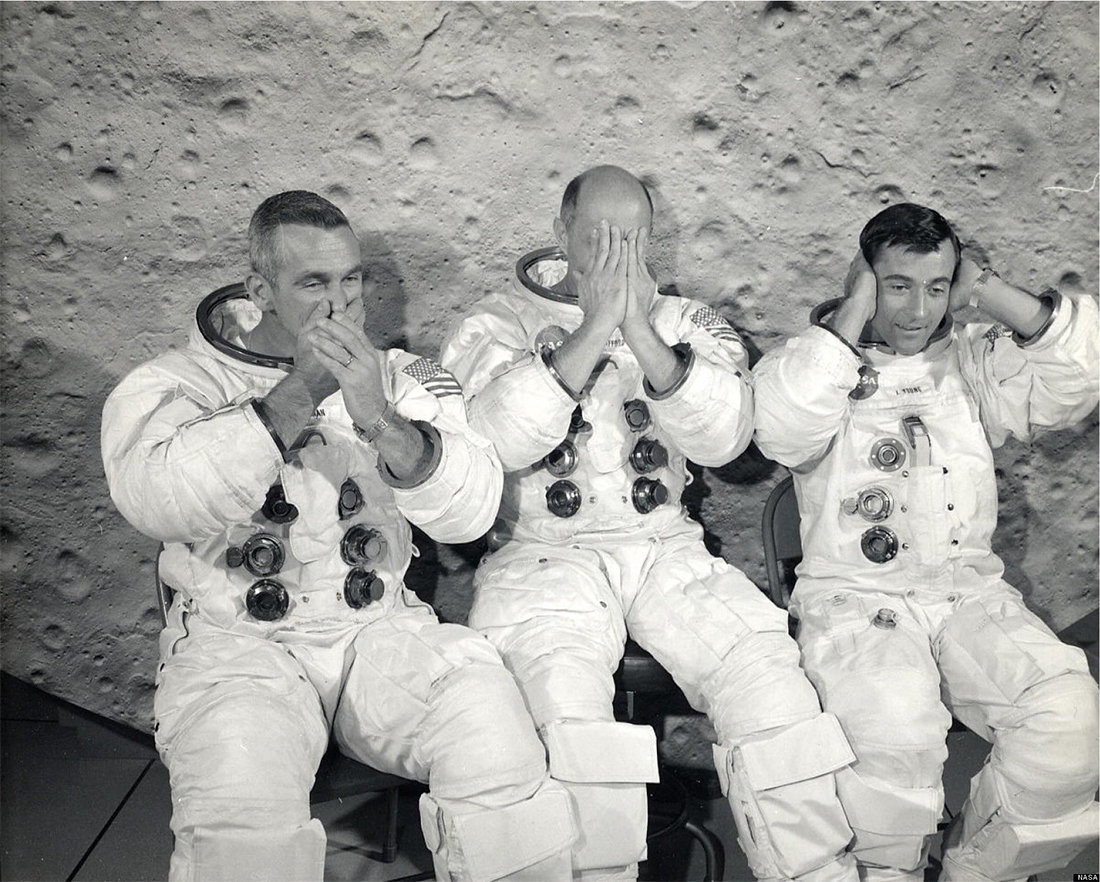
Many remember the first man in space, outer space and on the moon. German Titov , Edward White and Buzz Aldrin are second only to fewer, but almost no one remembers the third. Similarly, the Apollo 12 mission took place in the shadow of its famous predecessor, although it turned out to be perhaps the most interesting and fun of all Apollo missions. So let's say the commanders of Apollo 11 and Apollo 12 began their exits to the moon:
Neil Armstrong (1 m 80 cm) descending from the landing heel to the surface of the moon:
Pete Conrad (1 m 68 cm) jumping from the bottom rung of the ladder (when extending the telescopic legs of the lunar module from it to the surface there was a gap of 76 cm ):
The story goes that Konrad bet $ 500 with Italian journalist Oriana Fallaci that NASA is preparing the astronauts' speech in advance, so he decided to dissuade her from it. As laughingly spoke about this case, Conrad himself later - he had no thought of making money from this bet (and in the end he never received it). One way or another, there was no consequence for Konrad in the service at NASA - after this incident, he flew into space for the 4th time as part of the Skylab-2 mission.
Video recording of the exit of Conrad to the moon
Apollo 8:
Since the crew of this mission had to spend Christmas in space, NASA included three miniature cognac bottles in their Christmas dinner. The son of one of the members of the ground control group asked who then controls the capsule, if they all are currently drinking? To which the astronaut William Anders replied: “I think for the most part Isaac Newton now controls.”
Apollo 11:
It would seem that in this flight 600 million people were observed should not have left white spots, but there is still some little known in this mission - so here’s part of the negotiations of Apollo 11 astronauts before launching them from the Moon:
Naturally, there was no runway and no second ship on the moon, and this was just a joke by Buzz Aldrin. In 2015, he published a scan of his voucher for a trip along the route Houston - Cape Canaveral - Luna - Pacific Ocean - Hawaii - Houston in which the amount he received during the flight to the Moon was as much as $ 33.31 (which, considering inflation is about 225 dollars or pay 0.045 cents per mile of travel, which is about 10 times less than the payment for work of truckers). In addition to these modest travelers as military officers, Buzz Aldrin and Neil Armstrong received $ 17,000 a year ($ 115,000 with inflation).
If this does not seem strange to you - here is another form 7507 of the US Customs and Border Guard Service in which Neil Armstrong, Buzz Aldrin and Michael Collins declare samples of moonstones and dust from the moon to Honolulu Airport (Hawaii), and in the column “any other state” On board, which can lead to the spread of the disease "is marked" to be determined "(at that time they were in the 3-week quarantine).
As Buzz wrote about this quarantine on Twitter: “It was always amusing for me that the rags with which we were wiped from moon dust were thrown into the ocean. Thus, the poor underwater creatures got our moon microbes. "As he added to this later:" The moon dust that fell into the ocean could be an inspiration for the Godzilla film. I demand the right to the film! ”He joked (the fans proposed to rename“ Godzilla ”to“ Basilla ”at all). Earlier this year, Buzz Aldrin also began his modeling career (at 87) speaking at the New York fashion week with Bill Nyem :
Apollo 12:
The adventures of this crew began long before the start, or more precisely, at the moment when the team preparing the Yankee Clipper command module for flight found a cockroach in it. Whether he went to the circling of the moon, or got out of the module before the flight - history is silent, because he was never found.
The next event took place already at 36.5 seconds of flight and at an altitude of about 2.5 km, when lightning hit the ship. As Alan Bean said later: “The alarm went off. So many lights at the same time I have never seen all the tests on the simulator. "Well, so that the astronauts did not seem enough ... after 16 seconds at a height of 5.5 km a second lightning struck the ship! (Who said here that the projectile did not fall twice into one funnel?) This time the crew didn’t get off the alarm with one alarm: the Command Module failed the main power supply and, although it immediately switched to backup batteries, the ship’s control panel trees ”went into a state of a lifeless set of lamps and toggle switches, and instead of telemetry, the center of flights began to receive some sort of nonsense.
The crew had only a few seconds to rectify the situation, or the center of flights would have had to turn on the SAS system in order to lead the ship away from the rocket, after which it was to be blown up. Fortunately, 24-year-old John Aaron was on the flight management team at the time. He proposed to switch the electronic signal processing system to a spare power source (literally it sounded like “Try SCE to AUX”) to which the flight director and CAPCOM (responsible for all communication with the astronauts) answered: “What? What is it? ”, And after explaining the role of this CAPCOM thing and sending the team to astronauts, they already heard from one of them (Pete Conrad)“ What the hell is that? ”.

The position of this switch on the panel
Fortunately, Alan Bean was familiar with this switch (for some of the many tests that they passed) and quickly found it. Despite the fact that the mission and the lives of the astronauts themselves were just hanging by a thread, Charles Conrad managed to squeeze a joke out of himself saying “I think we need a little more all-weather tests.” The mission was saved, and John Aaron eventually received the nickname "rocket man with steel eyes" - just six months later he would participate in the rescue of the next ship (Apollo 13), picking up the revival mode of the command module during the preparation of his entry into the atmosphere the moment was well beaten in the same film ).
I think that by this moment the reader could well have a reasonable question: "where is vandalism after all?" The fact is that the main goal of the Apollo-12 mission was to reach the descent module Surveyor-3 and assemble parts of its parts and paint samplesfor souvenirs for further analyzes. And since the lunar car appeared only to Apollo-15 - all 177 meters that remained after landing to Surveyor-3 (it was impossible to get closer due to the risk of contamination of samples from the rocket engine exhaust), the astronauts had to overcome on foot (despite the fact that it turned out to be soft - the thickness of the dust layer in this area was significantly greater than the landing site of Apollo 11).
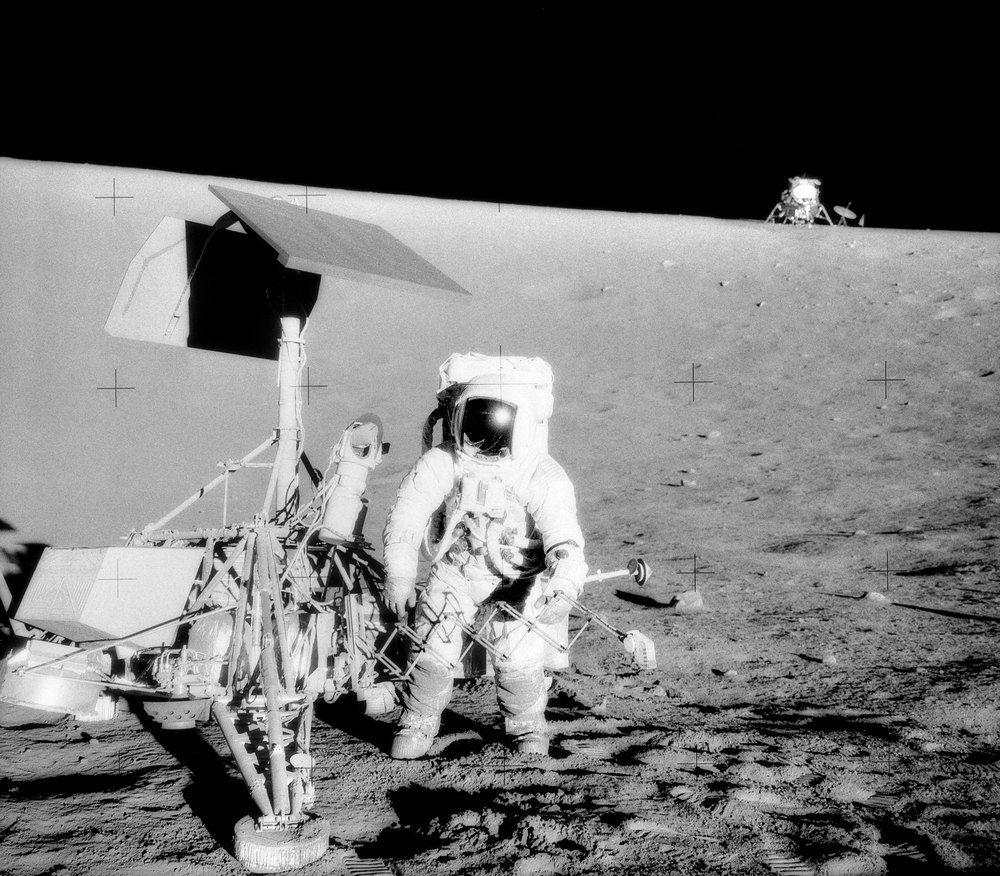
The painting “PatKote Surveyor”, the photo shows Pete Conrad next to the descent vehicle, on the horizon line you can see the Moon module and the directional communication antenna.
Already on the surface of the moon, another incident happened to them: Alan Bean accidentally sent a color camera to the Sun that was supposed to shoot their way out to the surface (although the astronauts were instructed not to direct the camera not to direct the camera toward the Sun). This put the camera out of action and almost immediately after that the broadcast of the output had to be stopped. The camera was eventually decided to be returned to Earth for the edification of careless astronauts in order to clarify the cause of the disabling camera. As samples from Surveyor-3, they managed to remove a camera (on which streptococci were found , which according to different versions either survived 2.5 years on the surface of the Moon, or were recorded on the surface of the device already on Earth due to poor sterilization), the bucket which assessed the mechanical properties of the soil, a number of other parts, samples of peeling paint and other debris .
It must be said that the backup crew of Apollo-12 was not inferior to the main one in terms of humor and printed on the instructions for going to the surface (which the astronauts wore on the spacesuit cuffs) along with several harmless jokes and pictures:
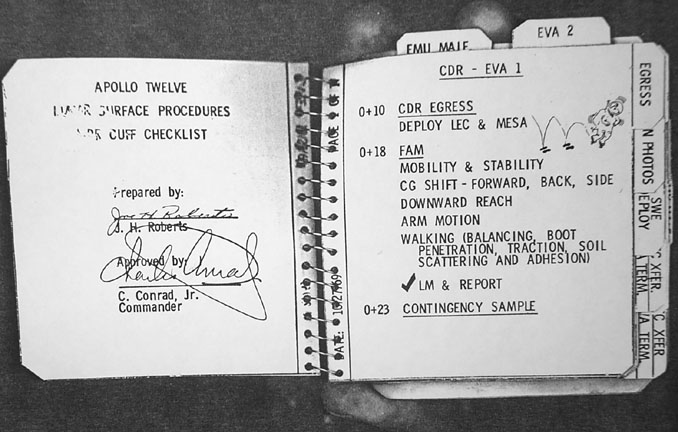
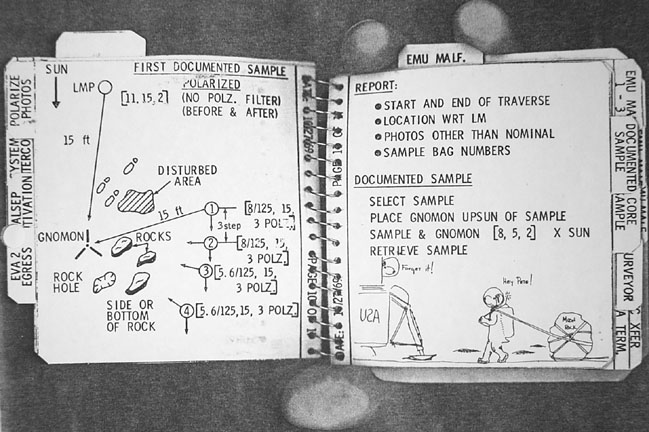
Be careful!
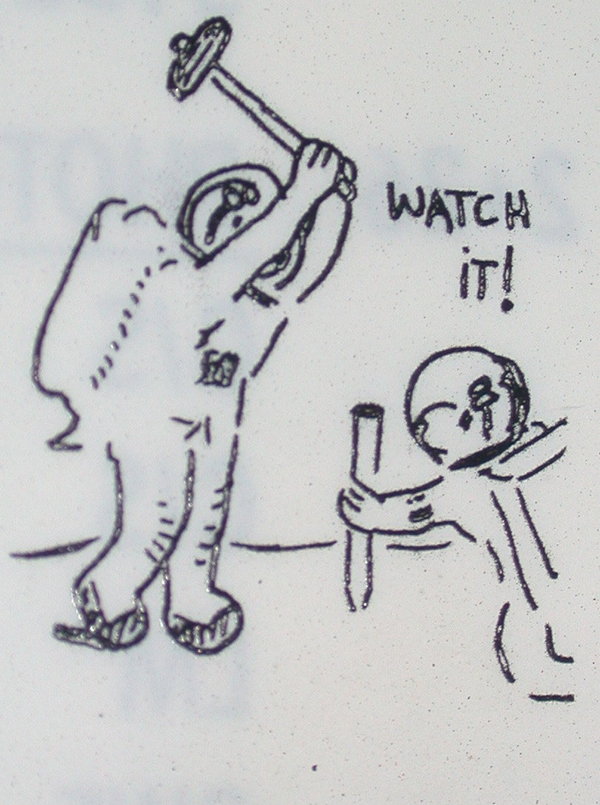
It is a nice place to visit, but ...

See all pages of these instructions here on the NASA website.
Before departing from the moon with the astronauts, there was another epic fail when, instead of a blank film, Alan Bean threw out several rolls of footage. Fortunately, the way back was already without excesses. Now Surveyor-3’s camera,along with everything streptococcus found, is on display at the National Museum of Aeronautics and Astronautics in Washington:

The landing on the far side of the moon was considered as a target for the Apollo 18 mission, with a satellite repeater in the lunar orbit, but this option was considered too dangerous, and the mission itself was completely canceled. During the Apollo 20 mission, they were going todisassemble parts to visit and explore Surveyor 7, but this mission was also canceled.
Apollo 15
Already at the end of this mission, astronaut David Scott performed the famous Galileo experiment on dropping a heavy and light object from a height (in this case, a 1.32 kg aluminum hammer and a falcon feather weighing 30 grams were used):
Fallen objects raised a cloud of dust, which astronaut's white spacesuit smeared, to which one of the members of the ground control joked: "My children are not so dirty as you." To which Scott replied: "Yes, but I am sure that they are not having so much fun."
In general, astronauts (including those who flew to the moon) were the same people as everyone else, so nothing human was alien to them ... including mistakes: our vestibular apparatus was not used to working with a gravity of 0.17 g and the astronauts did not have time for adaptation, so sometimes they just fell, and some of these falls were captured on camera:
On the 22nd second, a deliberate experiment was captured.
Not without humor, Margaret Hamilton's group wrote the code for the Apollo command and lunar module onboard control computer — one of the files with the code responsible for starting the engine of the Lunar module was titled “Burn_Child_Gr — Start_Collection_Basic_Digital.s” ”. The comments also contain quotes from Shakespeare, and the code responsible for moving the landing radar antenna to the working position is commented on as “turning this stupid thing”.
 Margaret Hamilton on the background of the Apollo code printout
Margaret Hamilton on the background of the Apollo code printout
The original code of the command and lunar modules were scanned from the original MIT documents in 2003 and posted on GitHub, where one of the users had already initiated a discussion for the “bug”, which Apollo 13 crew caught .
Well, some news:
SpaceX received a "green light" from NASA on the use of flight-tested steps in their missions, therefore, in the mission of the CRS-13 scheduled for December 4, the ship (from CRS-6) and the first step (from CRS-11) will be reused. This mission will also be launched from the SLC-40 launching table of the newly restored after AMOS-6 accident.
Only yesterday, data were published that, more recently, by geological standards (110 million years ago), water flowed from under the glaciers on Mars, which left traces on the surface.
NASA has prepared a model showing the connection of melting glaciers to the rise of water in 293 different ports (for some reason, there is no St. Petersburg and Murmansk, but there are Nikolskoye and Polyarny that are close to them).
China is going to land a probe on Mars by the end of 2021 .
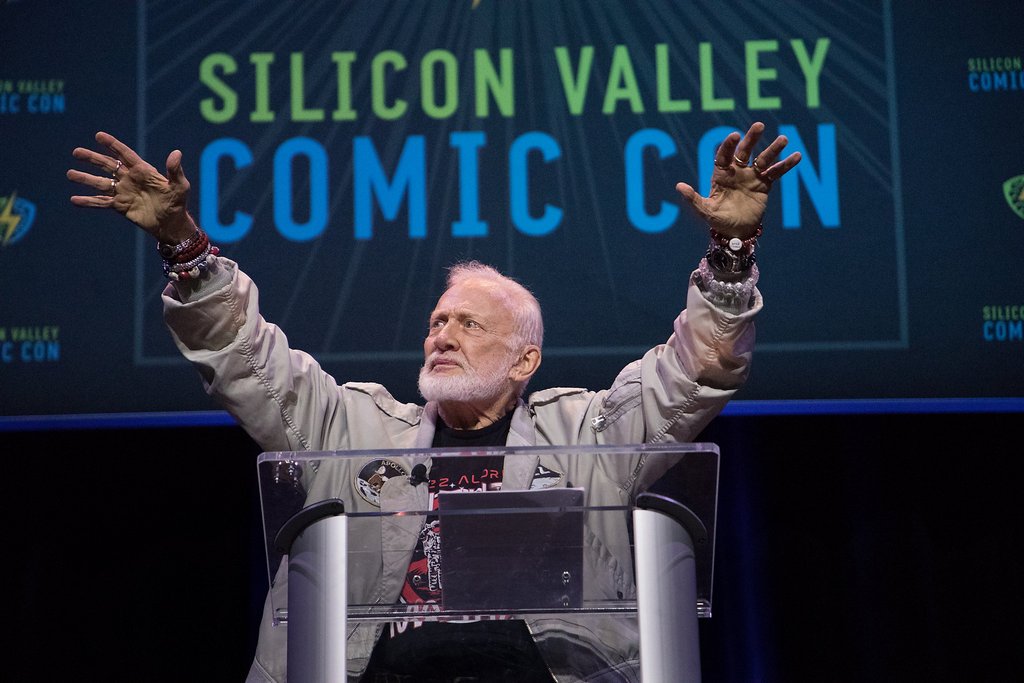
Thanks for attention!

Many remember the first man in space, outer space and on the moon. German Titov , Edward White and Buzz Aldrin are second only to fewer, but almost no one remembers the third. Similarly, the Apollo 12 mission took place in the shadow of its famous predecessor, although it turned out to be perhaps the most interesting and fun of all Apollo missions. So let's say the commanders of Apollo 11 and Apollo 12 began their exits to the moon:
Neil Armstrong (1 m 80 cm) descending from the landing heel to the surface of the moon:
This is a small step for man, but a giant leap for all mankind.
Pete Conrad (1 m 68 cm) jumping from the bottom rung of the ladder (when extending the telescopic legs of the lunar module from it to the surface there was a gap of 76 cm ):
Whoopie! Maybe it was a small step for Neal, but a big one for me.
I'm going to take a step off the court.
Mark. Oooh ... she is soft and gentle.
The story goes that Konrad bet $ 500 with Italian journalist Oriana Fallaci that NASA is preparing the astronauts' speech in advance, so he decided to dissuade her from it. As laughingly spoke about this case, Conrad himself later - he had no thought of making money from this bet (and in the end he never received it). One way or another, there was no consequence for Konrad in the service at NASA - after this incident, he flew into space for the 4th time as part of the Skylab-2 mission.
Video recording of the exit of Conrad to the moon
Apollo 8:
Since the crew of this mission had to spend Christmas in space, NASA included three miniature cognac bottles in their Christmas dinner. The son of one of the members of the ground control group asked who then controls the capsule, if they all are currently drinking? To which the astronaut William Anders replied: “I think for the most part Isaac Newton now controls.”
Apollo 11:
It would seem that in this flight 600 million people were observed should not have left white spots, but there is still some little known in this mission - so here’s part of the negotiations of Apollo 11 astronauts before launching them from the Moon:
Ron: Base of calm, this is Houston.
Neal: Accepted, go ahead.
Ron: Accepted. Our guide recommendations for PGNCS and takeoff permission.
Buzz: Accepted. Clear. We are the first on the runway.
Naturally, there was no runway and no second ship on the moon, and this was just a joke by Buzz Aldrin. In 2015, he published a scan of his voucher for a trip along the route Houston - Cape Canaveral - Luna - Pacific Ocean - Hawaii - Houston in which the amount he received during the flight to the Moon was as much as $ 33.31 (which, considering inflation is about 225 dollars or pay 0.045 cents per mile of travel, which is about 10 times less than the payment for work of truckers). In addition to these modest travelers as military officers, Buzz Aldrin and Neil Armstrong received $ 17,000 a year ($ 115,000 with inflation).
If this does not seem strange to you - here is another form 7507 of the US Customs and Border Guard Service in which Neil Armstrong, Buzz Aldrin and Michael Collins declare samples of moonstones and dust from the moon to Honolulu Airport (Hawaii), and in the column “any other state” On board, which can lead to the spread of the disease "is marked" to be determined "(at that time they were in the 3-week quarantine).
As Buzz wrote about this quarantine on Twitter: “It was always amusing for me that the rags with which we were wiped from moon dust were thrown into the ocean. Thus, the poor underwater creatures got our moon microbes. "As he added to this later:" The moon dust that fell into the ocean could be an inspiration for the Godzilla film. I demand the right to the film! ”He joked (the fans proposed to rename“ Godzilla ”to“ Basilla ”at all). Earlier this year, Buzz Aldrin also began his modeling career (at 87) speaking at the New York fashion week with Bill Nyem :
Apollo 12:
The adventures of this crew began long before the start, or more precisely, at the moment when the team preparing the Yankee Clipper command module for flight found a cockroach in it. Whether he went to the circling of the moon, or got out of the module before the flight - history is silent, because he was never found.
The next event took place already at 36.5 seconds of flight and at an altitude of about 2.5 km, when lightning hit the ship. As Alan Bean said later: “The alarm went off. So many lights at the same time I have never seen all the tests on the simulator. "Well, so that the astronauts did not seem enough ... after 16 seconds at a height of 5.5 km a second lightning struck the ship! (Who said here that the projectile did not fall twice into one funnel?) This time the crew didn’t get off the alarm with one alarm: the Command Module failed the main power supply and, although it immediately switched to backup batteries, the ship’s control panel trees ”went into a state of a lifeless set of lamps and toggle switches, and instead of telemetry, the center of flights began to receive some sort of nonsense.
The crew had only a few seconds to rectify the situation, or the center of flights would have had to turn on the SAS system in order to lead the ship away from the rocket, after which it was to be blown up. Fortunately, 24-year-old John Aaron was on the flight management team at the time. He proposed to switch the electronic signal processing system to a spare power source (literally it sounded like “Try SCE to AUX”) to which the flight director and CAPCOM (responsible for all communication with the astronauts) answered: “What? What is it? ”, And after explaining the role of this CAPCOM thing and sending the team to astronauts, they already heard from one of them (Pete Conrad)“ What the hell is that? ”.

The position of this switch on the panel
Fortunately, Alan Bean was familiar with this switch (for some of the many tests that they passed) and quickly found it. Despite the fact that the mission and the lives of the astronauts themselves were just hanging by a thread, Charles Conrad managed to squeeze a joke out of himself saying “I think we need a little more all-weather tests.” The mission was saved, and John Aaron eventually received the nickname "rocket man with steel eyes" - just six months later he would participate in the rescue of the next ship (Apollo 13), picking up the revival mode of the command module during the preparation of his entry into the atmosphere the moment was well beaten in the same film ).
I think that by this moment the reader could well have a reasonable question: "where is vandalism after all?" The fact is that the main goal of the Apollo-12 mission was to reach the descent module Surveyor-3 and assemble parts of its parts and paint samples

The painting “Pat
Already on the surface of the moon, another incident happened to them: Alan Bean accidentally sent a color camera to the Sun that was supposed to shoot their way out to the surface (
It must be said that the backup crew of Apollo-12 was not inferior to the main one in terms of humor and printed on the instructions for going to the surface (which the astronauts wore on the spacesuit cuffs) along with several harmless jokes and pictures:


Be careful!

It is a nice place to visit, but ...

somewhat more serious:
Like black and white photos from Playboy magazine with comments like:
"Preferred tether partner" - "Preferred partner for the cable" (meaning the descent into the crater to the Surveyor-3)
“Don't forget - describe the protuberances” - a play on words: “Don't forget - describe prominences / protrusions”
“Seen any interesting hills & valleys?” - “Did you see any interesting hills and valleys?”
Do not move
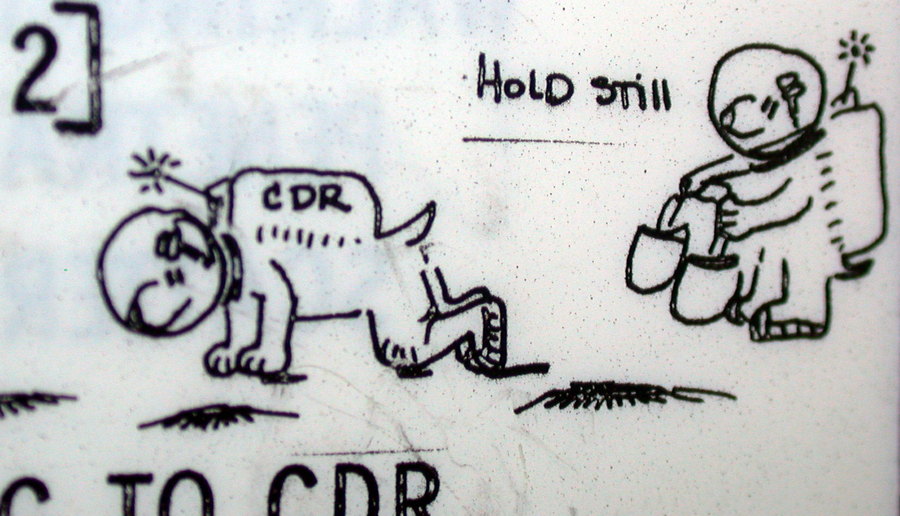
"Preferred tether partner" - "Preferred partner for the cable" (meaning the descent into the crater to the Surveyor-3)
“Don't forget - describe the protuberances” - a play on words: “Don't forget - describe prominences / protrusions”
“Seen any interesting hills & valleys?” - “Did you see any interesting hills and valleys?”
Do not move

See all pages of these instructions here on the NASA website.
Before departing from the moon with the astronauts, there was another epic fail when, instead of a blank film, Alan Bean threw out several rolls of footage. Fortunately, the way back was already without excesses. Now Surveyor-3’s camera,

The landing on the far side of the moon was considered as a target for the Apollo 18 mission, with a satellite repeater in the lunar orbit, but this option was considered too dangerous, and the mission itself was completely canceled. During the Apollo 20 mission, they were going to
Apollo 15
Already at the end of this mission, astronaut David Scott performed the famous Galileo experiment on dropping a heavy and light object from a height (in this case, a 1.32 kg aluminum hammer and a falcon feather weighing 30 grams were used):
Fallen objects raised a cloud of dust, which astronaut's white spacesuit smeared, to which one of the members of the ground control joked: "My children are not so dirty as you." To which Scott replied: "Yes, but I am sure that they are not having so much fun."
In general, astronauts (including those who flew to the moon) were the same people as everyone else, so nothing human was alien to them ... including mistakes: our vestibular apparatus was not used to working with a gravity of 0.17 g and the astronauts did not have time for adaptation, so sometimes they just fell, and some of these falls were captured on camera:
On the 22nd second, a deliberate experiment was captured.
Apollo program code
Not without humor, Margaret Hamilton's group wrote the code for the Apollo command and lunar module onboard control computer — one of the files with the code responsible for starting the engine of the Lunar module was titled “Burn_Child_Gr — Start_Collection_Basic_Digital.s” ”. The comments also contain quotes from Shakespeare, and the code responsible for moving the landing radar antenna to the working position is commented on as “turning this stupid thing”.
 Margaret Hamilton on the background of the Apollo code printout
Margaret Hamilton on the background of the Apollo code printout
The original code of the command and lunar modules were scanned from the original MIT documents in 2003 and posted on GitHub, where one of the users had already initiated a discussion for the “bug”, which Apollo 13 crew caught .
Well, some news:
SpaceX received a "green light" from NASA on the use of flight-tested steps in their missions, therefore, in the mission of the CRS-13 scheduled for December 4, the ship (from CRS-6) and the first step (from CRS-11) will be reused. This mission will also be launched from the SLC-40 launching table of the newly restored after AMOS-6 accident.
Only yesterday, data were published that, more recently, by geological standards (110 million years ago), water flowed from under the glaciers on Mars, which left traces on the surface.
NASA has prepared a model showing the connection of melting glaciers to the rise of water in 293 different ports (for some reason, there is no St. Petersburg and Murmansk, but there are Nikolskoye and Polyarny that are close to them).
China is going to land a probe on Mars by the end of 2021 .

Thanks for attention!
All Articles